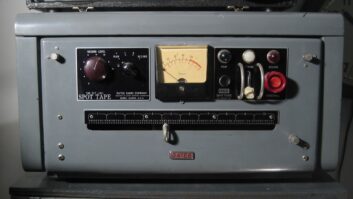(click thumbnail)In a world of AC-powered Internet radios, the British-built Revo Pico Wi-Fi is unique.
Revo bills the Pico Wi-Fi as having “supreme portability” by virtue of its onboard rechargeable NMH battery pack and Wi-Fi Web connectivity. But do these qualities combine to create a true portable radio, along the lines of an AM/FM portable?
Specs
The Revo Pico Wi-Fi — which sells for $349.95 at www.ccrane.com — essentially is a small loudspeaker with an Internet radio built in. It incorporates a 6 Watt mono amplifier and uses a 2 inch neodymium driver. Also included is a conventional FM tuner, a welcome feature for those times when tuning locally is preferred.
The Pico Wi-Fi does not have AM or HD Radio capabilities. It does have an extendable antenna for better FM reception.
Physically, the Pico Wi-Fi’s front has a two-line illuminated LCD screen at the top, with a two-way turning dial (really a plastic circle with a thumb indent) flanked by three function buttons on each side. The left side’s buttons cover On/Off, Browse and Back functions, and the right three Internet Radio/FM, Volume and Reply.
The dial can be pushed in, to serve as an Enter key. When used with the Back button, the tuning dial and push-in feature allows you to download a list of Internet radio stations from www.reciva.com, the maker of the Pico Wi-Fi’s software. (Reciva also supplies tuning software and support to other Internet radio manufacturers such as Acoustic Energy and Tangent.) The push-in dial also provides access to the Pico Wi-Fi’s treble and bass controls.
The Pico comes with a small remote control. It can used to tune the receiver and adjust its volume, and to store up to 10 station presets (five FM, five Internet radio). Because it connects to a Wi-Fi network — presumably one used by computers with media files — the Pico Wi-Fi can be used to access, sort through and play back audio files through its single speaker.
Besides these features, the Pico WiFi has a front-accessible M-Port, a female miniature plug jack (protected by a rubber sealing tab) that accepts an input plug from an iPod or other MP3 player. There is a miniature plug headset jack on the back, above a jack for the radio’s 12 V DC adaptor. Both openings can be sealed shut with an attached rubber panel, but only if nothing is plugged into them.
(click thumbnail)The M-Port female miniature jack, under this rubber tab, accepts an input from an MP3 player.
A software reset button is also located here, for those times when the Pico Wi-Fi’s software goes on the fritz. To date, I have not had to use this feature.
The case is charcoal gray plastic, and measures 6.5 inches tall by 4 wide by 4 thick. It is splashproof: “Pico’s case is sealed against the elements, allowing Pico to be used outdoors, or in places where there is moisture, such as a bathroom,” states the user manual. “Pico has been designed to withstand small splashes of water, such as raindrops. It is not designed to be submerged in water.”
Performance
In terms of tuning, the Revo Pico has the same perks and problems of any Reciva-based Internet radio.
The plusses include the thousands of stations made available by www.reciva.com, which can be downloaded and updated directly to the Pico Wi-Fi using its Internet connection.
The Reciva list is used by the tuner: You get to drill down through the list by station or location (country), then dig deep into musical and talk genres, from which you select the station you want. Of course, if you don’t recognizes the hundreds of station names that can be in a single genre category, making a choice can be difficult and time-consuming. That’s one of the big minuses with this system.
As for the Revo Pico Wi-Fi’s audio performance? Strangely enough, it seems to provide fuller and louder sound when tuned to an Internet radio station than when tuned to FM. Overall, the sound quality has reasonable and clarity range, but it isn’t enough to make you toss out your favorite FM portable. Still, it is quite pleasant for extended listening.
What about the Pico Wi-Fi’s much vaunted portability?
Well, given that its NMH batteries are rated to run 3–4 hours on a charge, this claim is reasonable. However, the Pico Wi-Fi’s reliance on Wi-Fi Internet connectivity is its Achilles heel.
Wi-Fi is notorious for being a short-range transmission medium. As a result, my test unit is unable to connect reliably to my Wi-Fi network when moved a floor above my wireless gateway.
This problem is not the Pico Wi-Fi’s fault, but it does undercut the notion that this unit is truly a portable radio. In the unit’s defense, its FM tuner can take over when its Wi-Fi link falls short. But if this is the case, why not just use a conventional AM/FM receiver and forego the Pico Wi-Fi’s cumbersome Reciva tuning system?
The Revo Pico Wi-Fi Internet Radio is about as portable as a modern Internet radio can be. In other words, it really isn’t.
However, the unit’s otherwise solid performance — it retained enough battery power to remember the stations last tuned, when the battery pack was too low to run the radio proper — makes the Pico Wi-Fi a worthwhile choice for first-timers wanting to try Internet radio.









